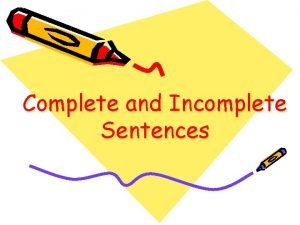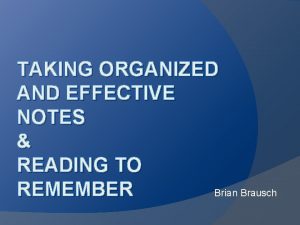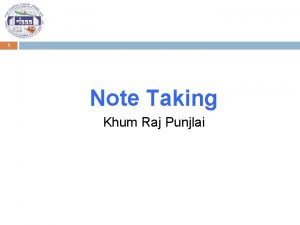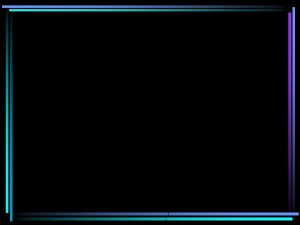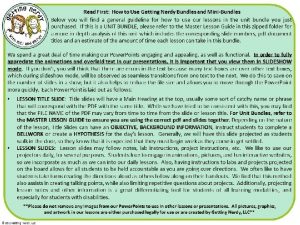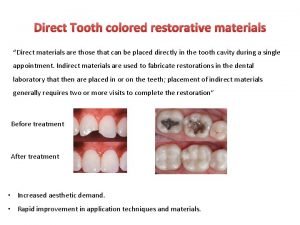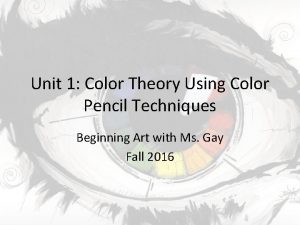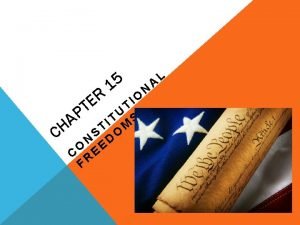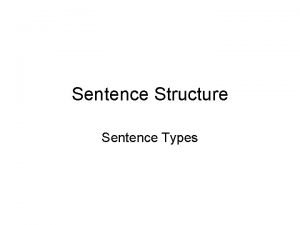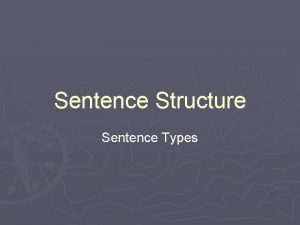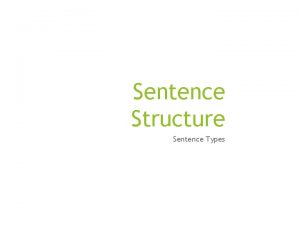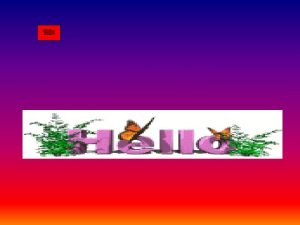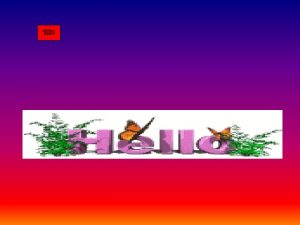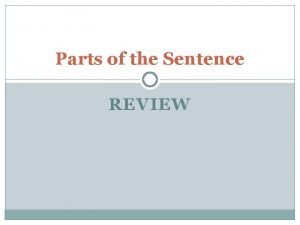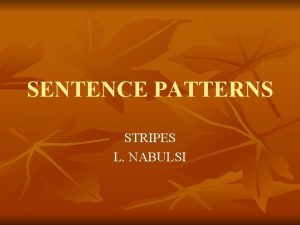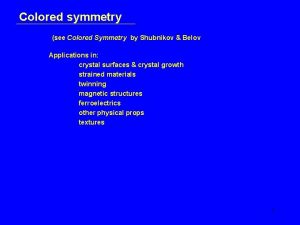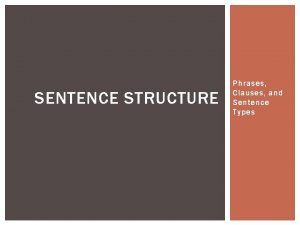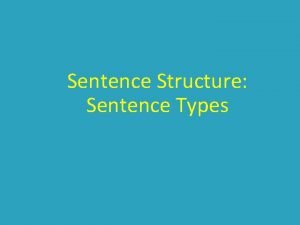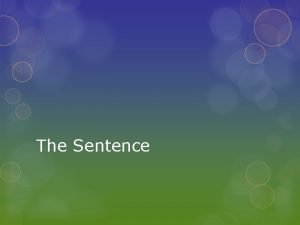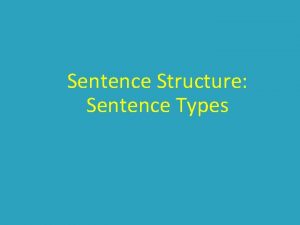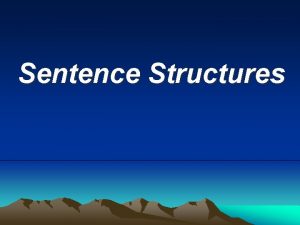SENTENCE PARTS AND PATTERNS NOTE Colored pencilspens may





















- Slides: 21

SENTENCE PARTS AND PATTERNS NOTE: Colored pencils/pens may come in handy for color -coding during this lesson!

WHAT PARTS MAKE A SENTENCE? Previously we learned… 1. Subject 2. Predicate Adding on… 3. Direct Object 4. Indirect Object

HOW TO FIND THE SENTENCE PARTS FIRST… look for the SUBJECT. To find the subject: Ask who/what is the sentence about? NEXT… find the VERB! To find the predicate: Ask what is the subject doing? (action verb, linking verb, or verb phrase) A sentence may have a DIRECT OBJECT, INDIRECT OBJECT, or BOTH! To find the direct object: Ask [verb] what? To find the indirect object: Ask [verb] to/for whom/what? EXAMPLE: I gave Mom a bouquet of weeds. PREDICATE: action/linking/verb phrase gave SUBJECT: Who/What [gave]? I Direct Object: [gave] what? a bouquet of weeds Indirect Object: [gave] to whom? Mom

FIND THE PARTS OF THIS SENTENCE: EXAMPLE #2: Tomorrow will be a snow day. § SUBJECT: who/what [verb]? § Tomorrow § PREDICATE: find an action verb, linking verb, or verb phrase § will be § Direct Object: [verb] what? § a snow day § Indirect Object: [verb] to/for whom/what? § nothing!

FIND THE PARTS OF THIS SENTENCE: EXAMPLE: At Barnes and Noble, the students bought their teacher a new book. § SUBJECT: who/what [verb]? § the students § PREDICATE: find an action verb, linking verb, or verb phrase § bought § Direct Object: [verb] what? § a new book § Indirect Object: [verb] to/for who/what? § their teacher § What’s “At Barnes and Noble”? § Prepositional phrase that tells more about the predicate “bought”

SENTENCE PARTS CREATE SENTENCE PATTERNS IN OUR LANGUAGE

FOUR SENTENCE PATTERNS: 1. Subject + Verb 2. Subject + Verb + Direct Object 3. Subject + Verb + Indirect Object + Direct Object 4. Subject + Linking Verb + Subject Complement

PATTERN #1: SUBJECT + VERB In its simplest form, a sentence has two parts: a subject and a verb. They express a complete thought when they are together. Remember a sentence is like a bike… Subject + Verb Answers who/what is doing the action? Options: noun or pronoun § Shows an action or a state of being § Options: action verb, linking verb, or verb phrase (helping verb + main verb)

EXAMPLES OF PATTERN #1: S+V Subject + Verb Plural noun Pronoun Plural noun Proper Noun Compound subject Dog barks. I am. Siblings argue. Al should go. He and I arrived. Action verb Linking verb Action verb Verb phrase Action verb

NOW YOU TRY… 1. Write an original sentence using this pattern: Subject + Verb Singular noun + action verb Plural noun + linking verb Singular subject pronoun + verb phrase Plural subject pronoun + action verb Proper noun + compound predicate 2. Find three examples of this pattern (SUBJECT + VERB) in your PCR book. Try to find a variety of subjects and verbs.

PATTERN #2: SUBJECT + VERB + DIRECT OBJECT Subject + Verb + Direct Object Who or What? Noun or pronoun ACTION verb OR VERB PHRASE (helping verb + action verb) Receives the action of the verb Ask yourself: [verb] what? Example: Jenny made a cake. § Subject: Jenny § Verb: made § Direct Object: cake

TRY THESE S+V+DO EXAMPLES: 1. Label the sentence parts: § Monkeys eat bananas. § She loves her job. § He’s eating an orange. 2. Find three examples of this pattern (SUBJECT + VERB + DIRECT OBJECT) in your PCR book. Try to find a variety of subjects and verbs.

ANSWERS: 1. Monkeys eat bananas. S V DO 2. She loves her job. S V DO 3. He’s eating an orange. S V DO

PATTERN #3: SUBJECT +VERB + INDIRECT OBJECT + DIRECT OB JEC T Subject + Verb + Indirect Object + Direct Object Who or What? Noun or pronoun ACTION verb OR VERB PHRASE (helping verb + action verb) Identifies to or for whom or what the action of the verb is performed Ask yourself: [verb] to/for whom/what? Receives the action of the verb Ask yourself: [verb] what? Example: Jenny made Dad a cake. § § Subject: Jenny Verb: made Indirect Object: Dad Direct Object: cake

TRY THESE S+V+IO+DO EXAMPLES: Label the sentence parts: 1. The teacher gave her students A's. 2. Grandfather will leave the dogs his money. 3. The pirate sold me his boat.

ANSWERS: 1. The teacher gave her students A's. S V IO DO 2. Grandfather will leave the dogs his money. S V IO 3. The pirate sold me a boat. S V IO DO DO

PATTERN #4: SUBJECT + LINKING VERB + SUBJECT COMPLEMENT Subject + Linking Verb + Subject Complement “To be” verbs like am, is, are, was, were, etc. Sensory verbs like appear, feel, grow, look, etc. § the adjective OR noun that follows a linking verb. § complement = completes the subject A linking verb LINKS the subject of the sentence to its subject complement; therefore, this pattern only works with linking verbs.

EXAMPLES OF S+LV+SC 1. Brandon is a gifted athlete. § Brandon = subject § is = linking verb § athlete = noun as subject complement. 2. He becomes embarrassed when people compliment his skill. § He = subject § becomes = linking verb § embarrassed = adjective as subject complement.

SUBJECT COMPLEMENT ≠ DIRECT OBJECT Don't mistake a subject complement for a direct object! Only linking verbs can have subject complements. § Example: Brenna felt sick this morning. § Brenna = subject § felt = linking verb § sick = adjective subject complement. § Example: She felt her forehead but did not detect a temperature. § She = subject § felt = action verb § forehead = direct object (Remember D. O. answers: [verb] what? )

PRACTICE: LABEL EACH SENTENCE WITH ITS SENTENCE PATTERN: Subject + + verb + direct object verb + indirect object + direct object linking verb + subject complement S V IO DO Example: The mother gave her children a snack. § Books convey ideas. § Dolphins leap. § The pitcher threw the catcher a curve ball. § John hates lima beans. § The sea is beautiful even in winter. § The writer sold his publisher a three-part story. § You seem worried. § Elizabeth will swim. (S + V) (S + V + DO) (S+V+IO+DO) (S + LV + SC)

ANSWERS: Subject + verb § Elizabeth will swim. § Dolphins leap. Subject + verb + direct object § John hates lima beans. § Books convey ideas. Subject + linking verb + subject complement § The sea is beautiful even in winter. § You seem worried. Subject + verb + indirect object + direct object § The writer sold his publisher a three-part story. § The pitcher threw the catcher a curve ball.
 Hci design patterns
Hci design patterns Difference between note making and note taking
Difference between note making and note taking Signal words example
Signal words example Difference between note making and note taking
Difference between note making and note taking Debit note and credit note
Debit note and credit note What is a debit note
What is a debit note Linear method of note taking
Linear method of note taking Financial documents in order
Financial documents in order Simple discount rate
Simple discount rate Examples of supporting sentences
Examples of supporting sentences Eclat algorithm
Eclat algorithm Short incomplete sentences
Short incomplete sentences In traditional dating patterns dating behavior
In traditional dating patterns dating behavior Sentence method of note taking
Sentence method of note taking Sentence method of note taking
Sentence method of note taking Classification of vowel
Classification of vowel Memory is deceptive because it is colored by today's events
Memory is deceptive because it is colored by today's events Sparta greece map
Sparta greece map Worm scienstructable 3d dissection model answer key
Worm scienstructable 3d dissection model answer key Tooth colored restorative materials
Tooth colored restorative materials Colored pencil techniques worksheet
Colored pencil techniques worksheet Colored water fountain
Colored water fountain











